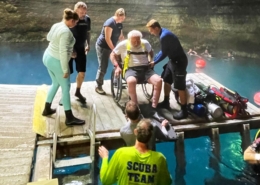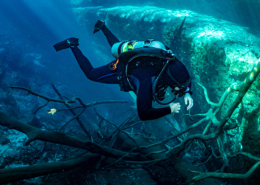What’s Under the Northeast Waters?
By Jon Knapp
The Northeast offers some great diving experiences, sometimes even better than the Caribbean! Surprisingly, diving in the Northeast doesn’t always get the recognition it deserves from the “dive gods,” but it offers comparable, if not superior, diving depending on your conditions. That’s right, dive conditions change when you’re not in the Caribbean. Off the coast of New Jersey, you can have days with infinite visibility, literally 110 feet at the bottom. You can look directly up and see the dive boat. There are days of hazy water conditions that open up at the bottom, and days where it’s clear going down and hazy on the bottom. I’ve had days off the New Jersey coast that would make Caribbean divers jealous! You might be wondering why you’d want to leave crystal-clear waters with infinite visibility. Well, you can come to scavenge, fish, or hunt for lobsters (warning: our lobsters fight back), or explore amazing shipwrecks.
It’s not just New Jersey either; there is New York, which is home to great wrecks in the ocean and freshwater, such as Saint Lawrence, with its pristine wrecks. Massachusetts offers lobstering, wrecks, and even a chance to dive with seals in their natural habitat. Rhode Island boasts magnificent sea walls and is known for the last U-boat sunk in US waters, among other Revolutionary War to WWII artifacts. Vermont has a number of wrecks dating back to the 1800s, and Maine offers opportunities to see crabs, lobsters, seals, and more wrecks! Each of these states has stunning scenery, federal and state parks/monuments, local breweries/wineries, and even some awesome lighthouses for when you’re not in the water.
What’s Different About Diving in the Northeast?
Diving in the Northeast comes with a few differences. Depending on the season, topside conditions can get cold (we have four seasons here), and it gets cold underwater too, so thermal barriers/protection are important, along with a redundant air source. For thermal protection, a 5mm or 7mm wetsuit will do just fine in the summer months, but for fall, winter, and spring diving, you may want to consider a drysuit. Diving in a 7mm wetsuit at the end of spring is doable but a bit chilly, while the end of winter into spring features the coldest water temperatures. The redundant air source is essential, as sometimes the unexpected happens. When it does, the redundant air source is for your safety, not to extend your time.
What’s Required for Diving in the Northeast?
An absolute must-have, which is not optional, is a finger spool (at least 150 feet) and a Delayed Surface Marker Buoy (DSMB). The recommendation of a 150-foot finger spool is to ensure that if you need to send up a DSMB, you’ll be able to reach the surface within recreational diving limits, even at a depth of 130 feet. Another purpose of this setup is that if the anchor line/mooring line/buoy line is no longer accessible, you can deploy a DSMB and tie off your finger spool on the wreck or dive site to create an upline for a safe ascent. Deploying your DSMB is a bit different in the Northeast compared to the Southeast/Caribbean. It still marks a diver’s location, but for us, it indicates an emergency, triggering the vessel or group’s emergency action plan (EAP). When diving wrecks, there is the possibility of entanglement, and in cold water, there is the possibility of becoming disoriented or being blown toward the wreck/site due to a current. Therefore, having your finger spool and DSMB within reach at all times is extremely important.
I also strongly recommend having specialties in nitrox, wreck diving, and deep diving to fully enjoy your time here. Deep diving is needed for most wrecks that are below the 60-foot open water limit. Learn proper wreck etiquette, such as using a wreck reel to avoid getting lost and prevent crossing lines, and nitrox to increase potential bottom time and have shorter surface intervals.
Come Have Some Fun!
If you’re thinking about diving in the Northeast, go for it! You won’t regret it, and you’ll become part of the Northeast diving family. If you’re wondering where to start, just search for it. There are plenty of boats and local shops throughout the Northeast, and many of them can provide a guide if it’s your first time, either included or for a fee.
Images provided by: Ocean Image Bank , and Ellen Cuylaerts












Ostavite odgovor
Želite li da se priključite diskusiji?Slobodno popunite!